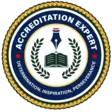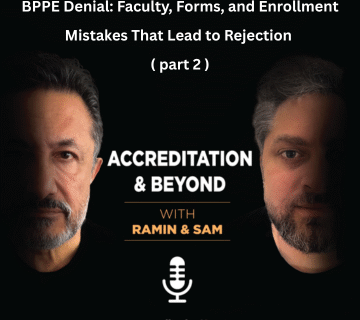
Introduction
Navigating BPPE compliance is a challenging journey that requires persistence and strategic planning. In this fifth installment of our comprehensive series on maintaining BPPE compliance, we focus on the stringent requirements surrounding advertising practices, self-monitoring procedures, and record-keeping.
Accreditation Expert Consulting aims to provide higher education universities, vocational schools, and colleges with the necessary guidance to ensure compliance with state authorizations, accreditation approvals, and all BPPE requirements.
Complying with BPPE regulations not only safeguards an institution’s reputation but also enhances its credibility in the educational sector. Institutions that remain vigilant in their compliance efforts can build trust with students, faculty, and regulatory bodies, ensuring long-term success.
According to BPPE’s 2023 annual report, over 200 institutions were fined for non-compliance, totaling more than $1.5 million in penalties.
Understanding BPPE Advertising Compliance
Reviewing Advertising Materials
A BPPE compliance analyst will inspect an institution’s advertising materials, including:
- Flyers, brochures, newspapers, and other print ads
- Digital content such as website information, social media posts, and online ads
Institutions must retain copies of all advertising materials for at least five years. This ensures that advertising:
✅ Accurately represents compliance with state standards
✅ Clearly states accreditation status
✅ Provides truthful information about programs and job placement rates
Key Areas of Advertising Review
- Approval and Accreditation Claims
- Clearly state that BPPE approval signifies compliance with state standards, not an endorsement.
- Ensure accreditation details are clear and verifiable.
- Learn more about accreditation
- Educational Program Representations
- Advertisements must accurately describe the availability, skills taught, and time required to learn specific trades or skills.
- Explore vocational school programs
- Mode of Delivery
- Clearly state whether programs are offered on-campus or online.
- Transparency in Job Placement Rates
- Institutions must back up all claims with verifiable data and comply with BPPE disclosure requirements.
BPPE’s latest audit revealed that 32% of institutions failed to provide accurate job placement statistics, leading to corrective actions and financial penalties.
Providing case studies or success stories from alumni can further reinforce credibility and set realistic expectations for prospective students.

Establishing Self-Monitoring Procedures for Compliance
Implementing Compliance Protocols
To maintain BPPE compliance, institutions should implement the following procedures:
- Designate compliance officers within the institution.
- Provide regular training for staff on the BPPE Act and relevant regulations.
- Stay updated with BPPE changes and attend bureau-sponsored workshops.
- Conduct internal audits to regularly review compliance measures.
✅ Creating a compliance checklist for staff can streamline internal audits and prevent oversights.
Ensuring Proper Record-Keeping During Inspections
Faculty and Student Files Review
BPPE compliance analysts conduct thorough inspections of faculty and student files to ensure compliance.
✅ Faculty Files
- Review of randomly selected faculty to confirm they meet BPPE’s minimum qualifications.
✅ Student Files
- Review of current, graduated, and withdrawn student records to verify academic progress and administrative compliance.
✅ Automation Tip: Using compliance management software for refund processing can minimize errors and improve efficiency.
Conclusion
Adhering to BPPE regulations requires a meticulous approach to advertising, record-keeping, and self-monitoring. By establishing clear protocols and regularly reviewing compliance practices, educational institutions can maintain good standing with the bureau.
Institutions that prioritize compliance not only avoid penalties but also create a more transparent and trustworthy environment for students and stakeholders. By staying proactive, schools can ensure continued growth and success.
For expert guidance in navigating BPPE compliance, visit Accreditation Expert Consulting. Our experienced professionals are here to support you in all aspects of compliance review and accreditation approval.
Stay tuned for Part 6, where we will explore additional compliance strategies to assist your institution in maintaining BPPE compliance.
FAQ – Frequently Asked Questions
Why is BPPE compliance important for educational institutions?
✅ Compliance ensures legitimacy, builds trust with students, and helps institutions avoid penalties.
How long must advertising materials be retained for BPPE audits?
✅ Institutions must keep all advertising materials for at least five years.
What happens if an institution provides misleading job placement data?
✅ Misleading claims can lead to BPPE penalties and loss of credibility.
Recent BPPE investigations have resulted in institutions facing fines up to $50,000 for false job placement claims.
How can institutions improve their compliance monitoring?
✅ Designate compliance officers, conduct regular audits, and implement self-assessments.
What should be included in student withdrawal records?
✅ Refund calculations, proof of processed refunds, and communication records should be well-documented.
For further assistance with BPPE compliance, contact Accreditation Expert Consulting.




